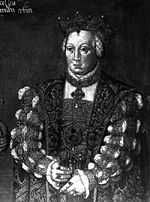Dorothea of Denmark, Electress Palatine
| Dorothea of Denmark | |
|---|---|
 Portrait by Michiel Coxcie, 1545 | |
| Electress Palatine | |
| Tenure | 1544–1556 |
| Spouse | Frederick II of the Palatinate |
| House | Oldenburg |
| Father | Christian II of Denmark |
| Mother | Isabella of Burgundy |
| Born |
10 November 1520 Copenhagen |
| Died |
31 May 1580 (aged 59) Neumarkt in der Oberpfalz |
| Burial | Holy Ghost Church in Heidelberg |
Dorothea of Denmark and Norway (November 10, 1520 – May 31, 1580) was a Danish, Norwegian and Swedish princess and an electress of the Palatinate as the wife of Elector Frederick II of the Palatinate. She was a claimant to the Danish, Norwegian and Swedish thrones.
Biography

Princess Dorothea was born on 10 November 1520 to King Christian II of Denmark and Norway and Isabella of Burgundy, sister of Holy Roman Emperor Charles V. Dorothea had an elder brother, Johann "Hans", born 21 February 1518. Her elder twin brothers, Philip Ferdinand and Maximilian, born 4 July 1519, had both died before her birth, the latter in 1519 and the former in 1520. Her sister Christina was born two years later, in 1522, and was her only sibling to reach adulthood. Christina would marry twice, first to Francis II, Duke of Milan, and secondly to Francis I, Duke of Lorraine.
On 20 January 1523, disloyal nobles forced her father to abdicate and offered the throne to his uncle, Duke Frederick of Holstein. That month, her mother gave birth to a stillborn son. Three-year-old Dorothea and her sister and brother followed their exiled parents to Veere in Zeeland, the Netherlands, and were taken care of by the Dutch regents, their grandaunt and aunt, Margaret of Austria and Mary of Hungary. Her mother died when she was five years old, on 19 January 1526. The Dutch court was an officially Catholic environment, but influenced with a sympathy for Protestantism, and Dorothea herself acquired Protestant sympathies early on.[1]
Her brother Hans died in 1532 at about fourteen years old. As the eldest surviving child of the abdicated Christian II, Dorothea had a claim to the Danish, Norwegian and Swedish throne. The Habsburg family selected Frederick of the Palatinate to be her consort, as they believed that he could successfully claim the Danish throne through marriage. She married Frederick in 1535 in Heidelberg. They had no children.
After the election of Christian III of Denmark to the Danish throne in 1536, her claims to the throne was realistically over, and after that point on, the Habsburg's supported her claim only in name.[2] Her spouse, however, continued to claim it from their court in Neumarkt. The Habsburg dynasty officially continued to supported their claim, but no longer took any action to press the matter. In 1544, her spouse became elector. The Habsburg family officially withdrew their support to their claim on the Danish and Norwegian throne the same year.
Dorothea and Frederick prevented the introduction of Protestantism that the Elector Palatine and Ottheinrich (Pfalz), his ward and successor, successfully pushed forward the Palatinate. Personally, Dorothea had Lutheran sympathies her entire life.
After the death of her husband in 1556, Dorothea lived modestly in Palatine castle in Neumarkt. As she had no children, Dorothea was no longer considered politically useful. There were considerations of marriage to a son of Philip of Hesse, or to Margrave Albrecht of Brandeburg, but non came to fruition, and the latter died in 1557. She died childless and was buried in the Holy Ghost Church in Heidelberg.
Ancestry
| Ancestors of Dorothea of Denmark, Electress Palatine | ||||||||||||||||||||||||||||||||||||||||||||||||||||||||||||||||||||||||||||||||||||||||||||||||||||||||||||||||||||||||||||||||||||||||||||||||||||||||||||||||||||||||||||||||||||||||||||||||||||||||||||||||||||||||||||||||||||||||||||||||||||||||||||||||||||||||||||||||||||||||||||||||||||||||||||||||||||||||||||||||||||||||||||||||||||||||||||||||||||||||||||||||||||||||||||||||||||||||||||||||||||||||||||||||||||||||||||||||||||||||||||||||||||||||||||||||||||||||||||||||||||||||||||||||||||||||||||||||||
|---|---|---|---|---|---|---|---|---|---|---|---|---|---|---|---|---|---|---|---|---|---|---|---|---|---|---|---|---|---|---|---|---|---|---|---|---|---|---|---|---|---|---|---|---|---|---|---|---|---|---|---|---|---|---|---|---|---|---|---|---|---|---|---|---|---|---|---|---|---|---|---|---|---|---|---|---|---|---|---|---|---|---|---|---|---|---|---|---|---|---|---|---|---|---|---|---|---|---|---|---|---|---|---|---|---|---|---|---|---|---|---|---|---|---|---|---|---|---|---|---|---|---|---|---|---|---|---|---|---|---|---|---|---|---|---|---|---|---|---|---|---|---|---|---|---|---|---|---|---|---|---|---|---|---|---|---|---|---|---|---|---|---|---|---|---|---|---|---|---|---|---|---|---|---|---|---|---|---|---|---|---|---|---|---|---|---|---|---|---|---|---|---|---|---|---|---|---|---|---|---|---|---|---|---|---|---|---|---|---|---|---|---|---|---|---|---|---|---|---|---|---|---|---|---|---|---|---|---|---|---|---|---|---|---|---|---|---|---|---|---|---|---|---|---|---|---|---|---|---|---|---|---|---|---|---|---|---|---|---|---|---|---|---|---|---|---|---|---|---|---|---|---|---|---|---|---|---|---|---|---|---|---|---|---|---|---|---|---|---|---|---|---|---|---|---|---|---|---|---|---|---|---|---|---|---|---|---|---|---|---|---|---|---|---|---|---|---|---|---|---|---|---|---|---|---|---|---|---|---|---|---|---|---|---|---|---|---|---|---|---|---|---|---|---|---|---|---|---|---|---|---|---|---|---|---|---|---|---|---|---|---|---|---|---|---|---|---|---|---|---|---|---|---|---|---|---|---|---|---|---|---|---|---|---|---|---|---|---|---|---|---|---|---|---|---|---|---|---|---|---|---|---|---|---|---|---|---|---|---|---|---|---|---|---|---|---|---|---|---|---|---|---|---|---|---|---|---|---|---|---|---|---|---|---|---|---|---|---|---|---|---|---|---|---|---|---|---|---|---|---|---|---|---|---|---|---|---|---|---|---|---|---|---|---|---|---|---|---|---|---|---|---|---|---|---|---|---|---|---|---|---|---|---|---|---|---|---|---|---|---|---|---|---|---|---|---|---|---|---|---|---|---|---|---|---|---|---|---|---|---|---|---|---|---|
| ||||||||||||||||||||||||||||||||||||||||||||||||||||||||||||||||||||||||||||||||||||||||||||||||||||||||||||||||||||||||||||||||||||||||||||||||||||||||||||||||||||||||||||||||||||||||||||||||||||||||||||||||||||||||||||||||||||||||||||||||||||||||||||||||||||||||||||||||||||||||||||||||||||||||||||||||||||||||||||||||||||||||||||||||||||||||||||||||||||||||||||||||||||||||||||||||||||||||||||||||||||||||||||||||||||||||||||||||||||||||||||||||||||||||||||||||||||||||||||||||||||||||||||||||||||||||||||||||||
References
Literature
- Dansk Kvindebiografisk Leksikon. KVinfo.dk (in Danish)
- Dansk biografisk Lexikon / IV. Bind. Clemens - Eynden
External links
![]() Media related to Dorothea of Denmark, Electress Palatine at Wikimedia Commons
Media related to Dorothea of Denmark, Electress Palatine at Wikimedia Commons
| Preceded by Sibylle of Bavaria |
Electress Palatine 1544–1556 |
Succeeded by Marie of Brandenburg-Kulmbach |